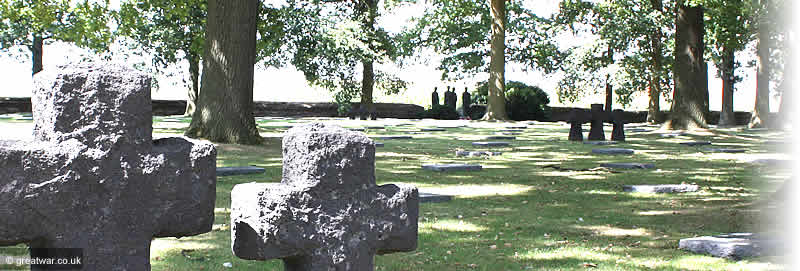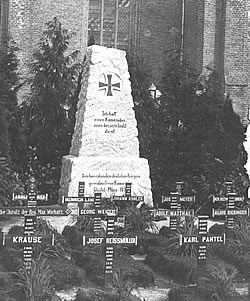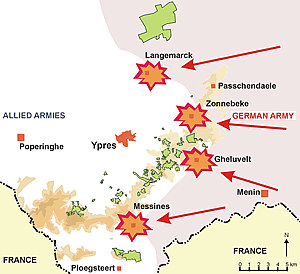Langemark German Military Cemetery, Belgium
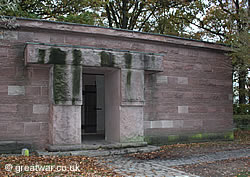
|
Langemark cemetery is one of only four First World War German cemeteries in the Flanders region. In the whole of Belgium there are 13 First and Second World War German military cemeteries.
Origins of Langemark Cemetery
The origins of this military cemetery began with a small group of German graves in 1915. Between 1916 and 1918 the burials at Langemark were increased by order of the German military directorate in Ghent. During the war the village was known by the spelling of Langemarck. In later times the “c” in the name was dropped.

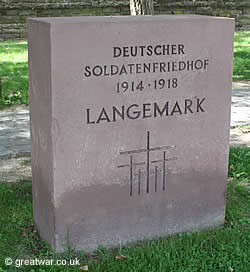
|
From the mid 1920s the private German war graves organization, the Volksbund Deutsche Kriegsgräberfürsorge (VDK) and the newly established Official German Burial Service in Belgium began to renovate German cemeteries in Flanders. At that time this cemetery was named “Langemarck-Nord”. This was done to distinguish the cemetery from the other 15 German burial sites in the Langemark area. The VDK secured private funds in the form of sponsorship from its members and was able to carry out significant work on two cemeteries in Flanders, namely this one at Langemarck-Nord (10,143 war dead) and another further north at Roeselaere called Roselaere-de Ruyter (2,806 war dead).
Official Inauguration
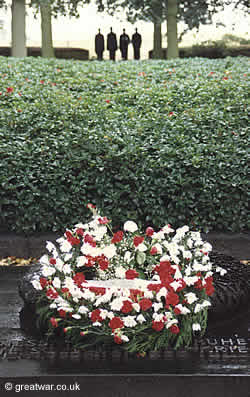
|
In 1930, with the setting up of a register of German military cemeteries in Flanders, more work was carried out at the cemetery and it was renamed “German Military Cemetery Number 123”.
Oak trees were planted; the oak is the national tree of Germany. The oak trees have grown very tall over the past 80 years and dominate the sombre atmosphere of this cemetery.
The cemetery was officially inaugurated on 10th July 1932.
The cemetery is now called “Langemark” cemetery.
Visit by Adolf Hitler, June 1940
In the Second World War, after the Battle of France in May 1940 the north and west of France and the whole of Belgium were occupied by the German Army. British and French troops had made a fighting withdrawal through this part of Flanders in south-west Belgium to the ports of Dunkirk and Calais, passing through some of the old battlegrounds of the First World War in the Ypres Salient. Some of the British casualties of May 1940 are buried in the Commonwealth War Graves Commission cemeteries side by side with British soldiers who died in this same place defending Belgian soil just over twenty years before them. The towns of Ypres and Poperinge were occupied for the next four years by the Germans until their liberation on 6th September 1944 by the Polish 1st Armoured Division.
A local man from Wytschaete, south of Ypres, who was a young boy at the time, recalled the impression it made on him suddenly to see a convoy of big black cars and lots of German officers in their grey uniforms driving near his family's farmhouse. He hid in the wood owned by his family and watched Adolf Hitler walking nearby with his entourage of officers. In the First World War Hitler had served with the Bavarian Reserve-Infantry-Regiment 16 and had been in action south of Ypres in the area of Wytschaete on the Messines Ridge.
Adolf Hitler spent two days visiting the Ypres Salient battlefields. His tour included the town of Ypres and Langemark military cemetery.
Statue of the Mourning Soldiers
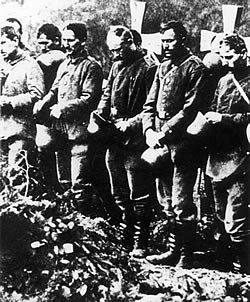
|
The bronze statue of the four figures in this cemetery was created by the Munich sculptor Professor Emil Krieger.
His inspiration was a photograph of soldiers from the Reserve-Infantry-Regiment 238. The photograph was taken in 1918 as the soldiers mourned at the grave of a comrade. This became a well-known photograph which appeared in the German press during 1918.
The second soldier from the right was killed two days after the photograph was taken.
The imposing statue was originally located near the entrance building. In later redevelopment of the cemetery it was moved to the western boundary of the cemetery.
These figures are a particular feature of this cemetery. Slightly larger than life they immediately capture the eye as visitors enter the cemetery through the gatehouse building. The figures stand solemly watching over so many thousands of German casualties of war. Even after visiting the cemetery numerous times, visitors will still find themselves drawn to look at the figures as they enter through the gate.
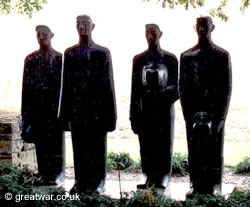
|
Three German Collecting Cemeteries
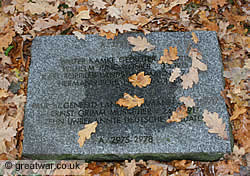
|
In 1954 an agreement was signed to establish three German collecting cemeteries for First World War dead in Flanders: Langemark, Menen and Vladslo. This decision was based on the experience of having to maintain many smaller cemeteries during the inter-war years outside Germany's borders on foreign soil. With more graves gathered together in fewer locations it was considered that the care and upkeep of the cemeteries could be carried out more effectively.
Over 9,000 Exhumations
From this time almost 9,500 German soldiers were brought into Langemark from 18 German burial sites in the area. The number of exhumations ranged from cemeteries containing from 54 to 1,562 burials.
Some burials were not identified by name, but were known to be German. These cemeteries included Langemark-Kerselaere, four cemeteries in Moorslede, two cemeteries in Passchendaele, five cemeteries in Poelcappelle, two cemeteries in Staden, one in Westroosebeke, two in Zillebeke and one in Zonnebeke-Polygone. Eight soldiers, identified and unidentified, were generally buried in each grave plot and their identities were marked with a grave number.
Unidentified Casualties to Langemark
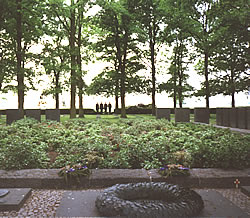
|
It was decided that all of the thousands of unidentified German dead being discovered in the fields and isolated burial sites during the clearance of the battlefields would be taken to Langemark for interment. This was because there was room in the cemetery to create a mass grave for a large number of casualties. The grave site would be called the “Kameraden Grab”, the Comrades Grave.
Renovation Work and Redevelopment
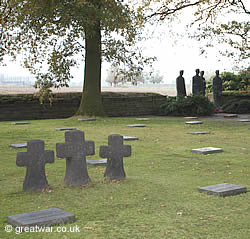
|
With the decision to bring the unidentified casualties to this place Langemark cemetery underwent a major redevelopment in the late 1950s.
Basalt-lava Crosses
Several groups of three basalt-lava crosses were placed in the grounds as an architectural feature. The three crosses reflect the motif of the group of different sized crosses used by the VDK since the 1920s. The motif itself comprised five crosses.
For more information about the motif and its origins see our page about the Volksbund Deutsche Kriegsgräber Fürsorge (VDK):
Volksbund Deutsche Kriegsgräber Fürsorge (VDK)
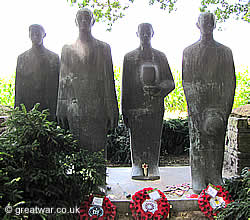
|
Four Figures Moved
The bronze statue of the four mourning soldiers, originally located near to the cemetery entrance was moved to the “horizon” of the cemetery on its western boundary.
The Kameraden Grab - The Comrades Grave
The Kameraden Grab (Comrades Grave) for the thousands of unidentified dead being brought into this cemetery was formally constructed.
Oak Panels for Unidentified Burials
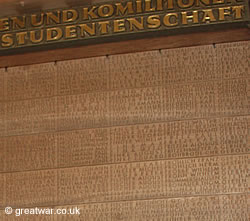
|
The names of hundreds of those known to be buried in the cemetery but not in identifiable graves were at that time carved on oak panels in a room on one side of the entrance building.
The other side of the entrance building contains a room with maps carved into the oak panelling, a Visitors' Book and information about the work of the German war graves agency, the VDK.
New Grave Markers
In 1971 more work was carried out at Langemark. The German war graves agency, the VDK, changed all the grave markers which had previously only given the grave number to stone tablets giving personal details for each soldier where possible. Where known the identity of a soldier was inscribed with a forename, family name, rank and the date of their death.

Bunkers
A basalt-lava cross was erected on one of the three original German battlefield bunkers which were left on the site and incorporated into the architecture of the cemetery.
Total Casualties in Langemark Cemetery
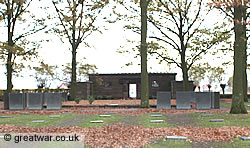
|
By the completion of the redevelopment work in 1984 the total number of identified dead buried in the cemetery totalled 19,378.
The remains of 24,916 unidentified German soldiers had been brought into the cemetery following battlefield clearance and had been interred in the newly created Kameraden Grab (“Comrades Grave”).
The total figure of casualties in this cemetery was by then 44,294 war dead.
In 1984 an international ceremony at Langemark was held to mark the completion of renovation work.
Identification of Langemark's Unidentified Burials
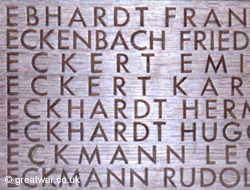
|
In recent years research by the VDK has identified 16,940 of the 24,000 previously ‘unknown’ soldiers brought to this place and buried in Langemark cemetery's Kameraden Grab (Comrades Grave). Since 1984 their identified names have been inscribed on bronze tablets surrounding the Kameraden Grab.
The Student Cemetery
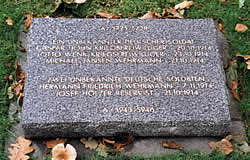
|
About 3,000 of the graves in the cemetery were those of young student volunteers who had died in the Battle of Langemarck in October and November 1914, during the First Battle of Ypres. They had the rank of Kriegsfreiwilliger, which translates as “war volunteer”. As a result of this the cemetery became known to the German people as “Der Studentenfriedhof”, which translates as the “Student Cemetery”.
Visitors' Entrance
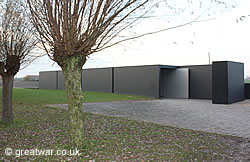
|
In recent years a new entrance for visitors to Langemark Cemetery has been built. Visitors can now park safely away from the main road in a designated car park at the north end of the cemetery.
There is a pathway from this car park along the northern boundary of the cemetery, through a specially designed tunnel and then along the eastern boundary of the cemetery, parallel to the main road, to the cemetery's entrance gate.
The tunnel is intended as a place to spend a few moments of reflection on entering and leaving the cemetery. There are five automated computer screens showing archive film from the Great War.
Location
Klerkenstraat 95, 8920 Langemark-Poelkapelle, Belgium
Latitude 50.920161; Longitude 2.917365
The cemetery is signposted from the centre of the village of Langemark and located to the north of the village on the west side of Klerkenstraat.
Access
There is a car park at the north end of the cemetery, away from the main road. It is suitable for cars and coaches. Access to the cemetery can be made safely from this car park along a flat path following the northern and eastern hedged boundary of the cemetery to the main entrance.
Related Topics
German WW1 Military Burials in Belgium
See our article about German burials in Belgium during the First World War and the work carried out to find a final resting place for these German casualties after the Armistice of November 1918.
German WW1 Military Burials in Belgium
Care for German War Graves
The Volksbund Deutsche Kriegsgräber Fürsorge (VDK) is responsible for the maintenance and care of German war graves around the world. For more information about the VDK and the origins of its work after the First World War go to:
Volksbund Deutsche Kriegsgräber Fürsorge (VDK)
Battles of the Ypres Salient
For an overview of the major battles in the Ypres Salient from the defence of Ypres in the First Battle of Ypres in October 1914, the creation of the Ypres Salient to the Allied successes in the Fifth Battle of Ypres in September 1918 see our page at:
Cemeteries and Memorials in the Ypres Salient
For a listing of British, French, German, Belgian and American cemeteries and/or memorials in the Ypres Salient, including map locations showing where to find them, see our pages:
Cemeteries in the Ypres Salient
Monuments and Memorials in the Ypres Salient
Acknowledgements
(1) Photograph of the mourning soldiers courtesy of Volksbund Deutsche Kriegsgräber Fürsorge.
(2) Photograph courtesy of the late Bridgeen Fox (Private Collection)
Some of the cemetery description and history has been sourced by kind permission of the Volksbund Deutsche Kriegsgräber Fürsorge. For further information about the graves in this cemetery visit the website of the Volksbund Deutsche Kriegsgräberfürsorge war graves agency:
Website: www.volksbund.de
